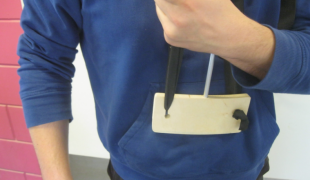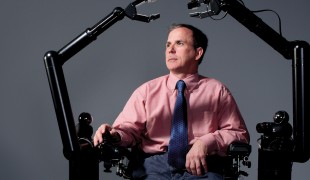- 1949
- 168
- 0
- 1
- 0
- Help Ukraine
About the solution
Shiva started thinking about creating this device in 2012, after he heard that a family member had lost both forearms.
“I decided to take matters into my own hands and design a prosthetic,” the inventor said.
This student’s innovation consists of a headset and an artificial arm that can be moved around by signals from a person’s brain that are transmitted over a wireless Bluetooth device. The arm only waves from side to side, while its fingers flex in and out. Nathan cannot control it very precisely.
The headset, which can detect brain waves and transmit the signals to a computer or smartphone via Bluetooth, was designed to work with meditation software. By viewing his own brain waves on a personal computer display, a user can teach himself how to relax.
Nathan already won an award at Mobile World Congress, in Barcelona, and is now working on upgrading his invention so it can be controlled with the eyes.
Adapted from: http://bit.ly/2mK4D4A
https://youtu.be/UQ1DwOpDOII
This solution shall not include mention to the use of drugs, chemicals or biologicals (including food); invasive devices; offensive, commercial or inherently dangerous content. This solution was not medically validated. Proceed with caution! If you have any doubts, please consult with a health professional.
DISCLAIMER: This story was written by someone who is not the author of the solution, therefore please be advised that, although it was written with the utmost respect for the innovation and the innovator, there can be some incorrect statements. If you find any errors please contact the patient Innovation team via info@patient-innovation.com
-
-
498
-
0
-
10025

Students invent aid so that amputee can play trombone
-
-
-
266
-
0
-
5052

Paralyzed man designs innovative wheelchairs
CAREGIVING
MOVING IN A WHEELCHAIR: Moving using a wheelchair.
Grip
Rubgy
Basketball
Paralysis
Cervical spinal cord injury/Tetraplegia
Assistive Daily Life Device (to help ADL)
Assistive Technology access
Walking Aid (wheelchair/walker/crutches)
Restoring mobility
Replacing lost limbs
Promoting self-management
Promoting inclusivity and social integration
Recovering from Traumatic Injuries
Preventing (Vaccination, Protection, Falls, Research/Mapping)
Caregiving Support
Neurology
Orthopedics
Physical Medicine and Rehabilitation
United States
-
-
-
361
-
0
-
5883

Man invents tattooing prosthetic arm
-
 en
en